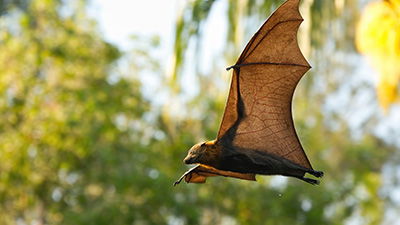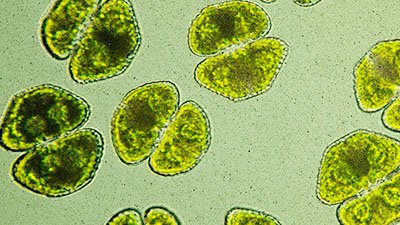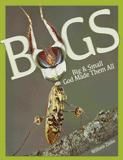
Parasitic Wasps
Did God design wasps to lay their eggs in living hosts?
Wasps are generally a loathed group of insects. They have unpleasantly painful stings that can, from personal experience, penetrate thin layers of clothing. Further, because some species make nests in the ground, they can easily attack unwary walkers or grass cutters, leading to multiple, painful, and sometimes temporarily debilitating stings. However, there is a massive group of wasps known not for ambushing grass cutters but for parasitizing other insects and arthropods. These are the parasitic1 wasps—some of the creepiest parasites living in the world today.
While the idea of a parasite may sound creepy, there are some organisms that greatly benefit from parasitic wasps. In fact, they even invite the wasps to visit them!2 Plants emit volatiles that attract parasitic wasps to feed or parasitize caterpillars (or other arthropods) that are eating the plant.3 The specific volatile released may differ depending on plant and wasp species.4 The wasps quickly learn5 to recognize these volatiles and follow them, looking for hosts.6 The wasps can remember multiple chemical signals at a time and remember the signals when exposed to them in the future.7 In at least one small species, the wasp is attracted to the mating signals of butterflies. It then hitches a ride on the female, and when she lays eggs, so does the wasp.8 Wasps can find hosts on their own too by tracking the vibrations associated with movement.9 Some potential hosts can try to disguise or reduce the released volatiles, using endosymbionts, which reduce the concentration of volatiles.10
While the idea of a parasite may sound creepy, there are some organisms that greatly benefit from parasitic wasps.
Parasitic wasps parasitize a wide array of hosts in the larval stage. However, the adults are largely nonparasitic, living mostly off nectar from flowers.11 Some species must find nectar daily to survive.12 Some species will also feed on their host, harvesting sugar-rich hemolymph either during the act of parasitism or as an ongoing food supply.13 Many species come equipped with venom, which they use to temporarily paralyze their victims.14 In other species, the venom disrupts the development of the host.15

Tomato plant with braconid wasp larvae parasitizing a hornworm (photo, courtesy of a coworker).
Since the parental wasps are not directly parasitic (in most cases), their use of hosts is through their larva. When they find a host, the females will oviposit eggs into the host. Once inside, the eggs in some species will undergo polyembryony, producing hundreds or even thousands of embryos from just one egg.16 All those babies must eat, and they are born into a food-rich environment: the innards of their host. Wasp larva will block its host’s maturation and simultaneously munch on the host tissue.17 Making it worse for the host, the parasitoid larvae can trick it into defending its tormentors, even protecting the wasps when they go into their cocoons.18 Some hosts can recover from their ordeal if the wasp larva dies or is removed, but it takes time and uses valuable energy.19 Other hosts use endosymbiotic bacteria as a sort of immune system against the wasp larva. The bacteria kill most if not all the wasp larva, leading to the host surviving.20 Some wasps attempt to get around this by depositing multiple eggs in a host infected with the bacteria, which does increase their likelihood of success.21
Some wasps partner with either viruses or bacteria to attack their hosts. In one species (but not a closely related one), if Wolbachia bacteria are removed, the wasps are unable to produce eggs.22 In other wasps, a virus is injected into the host alongside the wasp’s eggs. The virus provides protection for the eggs, improving their chances of survival.23 Other types of viruses pass from the mother to the egg then to the host where they replicate and cause paralysis of the host.24 It has also been suggested that these viruses protect the wasps against infection by other types of viruses.25 These viruses are crucial to the survival of many wasp species.
Evolutionists have proposed that the viruses were originally free-living and were “domesticated” by the wasps as part of their evolution.26 The viruses cannot replicate outside the wasps and purportedly evolved from at least two types of viral ancestors.27 According to this theory, the viruses serve as vectors to deliver genes to the host that allow the eggs to hatch and grow inside it.28 In other cases, the viruses serve not as vectors for genes but as delivery molecules for proteins.29
There are, as always, deep issues with this standard model. For example, one form of symbiotic virus, the ichnoviruses, has an unknown ancestor.30 An ancestor has been proposed, but it is not particularly similar to its supposed descendant. For the other major group, the bracoviruses, an ancestor has been proposed. There are two problems with the proposed ancestor. First, even evolutionists have admitted there are no genes from the purported ancestors found anywhere in the bracoviruses.31 In other words, they may be viral elements, but they do not look like leftovers of colonization. Second, some evolutionists have proposed that the supposed viral elements are not viral anymore but represent a wasp organelle system evolved to help them control their hosts.32 If the latter hypothesis simply left out the “anymore” and the evolutionary assumptions that go with it, it would imply a designed system. This is especially true since many species of wasps are completely dependent on these viruses to reproduce.33
Another obvious problem is that there is more than one kind of virus, with different effects on the host, involved in wasp parasitism.34 Evolving this system once would require the co-option of a virus by the wasp, the development of the lifestyle, which requires multiple specialized changes, and the ability in many cases to track chemical signals and vibrations of their potential hosts. Doing it at least twice makes the problem twice as difficult. Of course, there is the question of how the wasps reproduced before they acquired the viruses (estimated at roughly 100 million years ago).35 There are about 31,000 species of wasps carrying these viral elements (with another 27,000 species suspected to be undescribed).36
Worse still is the time problem. Substituting genes into a genome is instant, but substituting the gene in the whole population takes time. In one parasitoid wasp species, there are 35 separate locations where purported viral DNA is found, containing 40 separate viral DNA sites.37 Even if we grant an entire 100 million years (give or take a few million), how did 40 separate insertions spread through the population? Given that the process affects reproduction the question then becomes how many of those insertions are necessary for reproduction to occur. In other words, do those 40 loci all need to be present in the same organism at the same time? We don’t have the answer to that question, but it seems likely, from a creationist view, that most if not all of them are involved.
It is possible that parasitoid wasps once oviposited in fruits or the seed pods of flowering plants.
Using “inference to the best explanation,” what we have here is a designed system that has been expressed or twisted or both due to the curse. Many wasps today use fruit as the repository for their eggs.38,39,40 It is possible that parasitoid wasps once oviposited in fruits or the seed pods of flowering plants. Alternatively, they may have been designed as pollinators and, post-fall, may have interacted with viral substrates and become parasitic.41 Other hypotheses could also be proposed. The origin of attack/defense structures, like this one, is an active area of research. One thing, however, is certain. Parasitism, even if it had millions of years, could not develop through naturalistic evolution. Parasitic wasp reproduction has radically changed post-fall. The question is, how and why? These myriad complex interactions between wasp and host are far too complex to result from naturalistic processes. It appears that these sophisticated systems were designed and front-loaded into the creation (the work of creation was finished on day six) either with benign functions that degenerated at the fall or were designed to be parasitic but were latent until the fall. Regardless, at the fall, these insidious parasitic systems arose (the curse), subjecting the whole creation to futility. All creation has been groaning (Romans 8:20, 22). But there is a sure hope: “That the creation itself will be set free from its bondage to corruption and obtain the freedom of the glory of the children of God” (Romans 8:21).
Footnotes
- Technically that are parasitoid wasps because they usually cause the death of their host. Parasites do not necessarily cause death.
- Turlings, T. C., J. H. Loughrin, P. J. McCall, U. S. Röse, W. J. Lewis, and J. H. Tumlinson, “How Caterpillar-Damaged Plants Protect Themselves by Attracting Parasitic Wasps,” Proceedings of the National Academy of Sciences 92, no. 10 (May 1995): 4169–4174, https://www.pnas.org/doi/abs/10.1073/pnas.92.10.4169.
- Posthumus, M. A., L. Mattiacci, and M. Dicke, “Beta-Glucosidase: An Elicitor of Herbivore-Induced Plant Odor That Attracts Host-Searching Parasitic Wasps,” Proceedings of the National Academy of Sciences 92, no. 6 (March 1995): 2036–2040, https://www.pnas.org/doi/abs/10.1073/pnas.92.6.2036.
- Wei, J., L. Wang, J. Zhu, S. Zhang, O. I. Nandi, and L. Kang, “Plants Attract Parasitic Wasps to Defend Themselves Against Insect Pests by Releasing Hexenol,” PLoS One 2, no. 9 (2007): e852, https://journals.plos.org/plosone/article/file?id=10.1371/journal.pone.0000852&type=printable.
- Smid, H. M., G. Wang, T. Bukovinszky, J. L. M. Steidle, M. A. K. Bleeker, J. J. A. van Loon, and L. E. M. Vet, “Species-Specific Acquisition and Consolidation of Long-Term Memory in Parasitic Wasps,” Proceedings of the Royal Society of London Series B: Biological Sciences 274, no. 1617 (June 2007): 1539–1546, https://www.ncbi.nlm.nih.gov/pmc/articles/PMC2176164/.
- Turlings, T. C. J., J. H. Tumlinson, and W. J. Lewis, “Exploitation of Herbivore-Induced Plant Odors by Host-Seeking Parasitic Wasps,” Science 250, no. 1251 (1990): 1251–1253, https://www.researchgate.net/profile/James-Tumlinson/publication/33682640_Exploitation_of_Herbivore-Induced_Plant_Odors_by_Host-Seeking_Parasitic_Wasps/links/00b49520d109984924000000/Exploitation-of-Herbivore-Induced-Plant-Odors-by-Host-Seeking-Parasitic-Wasps.pdf.
- Lewis, W. J., D. M. Olson, G. C. Rains, T. Meiners, K. Takasu, M. Tertuliano, J. H. Tumlinson, and F. L. Wäckers, “Parasitic Wasps Learn and Report Diverse Chemicals with Unique Conditionable Behaviors,” Chemical Senses 28, no. 6 (July 2003): 545–549, https://doi.org/10.1093/chemse/28.6.545.
- Hilker, M., N. E. Fatouros, M. E. Huigens, J. J. A. van Loon, and M. Dicke, “Butterfly Anti-Aphrodisiac Lures Parasitic Wasps,” Nature 433 (2005): 704, https://www.nature.com/articles/433704a.pdf.
- Meyhöfer, R., and J. Casas, “Vibratory Stimuli in Host Location by Parasitic Wasps,” Journal of Insect Physiology 45 (1999): 967–971, https://casas-lab.irbi.univ-tours.fr/Meyhofer%20and%20Casas%201999_JIP.pdf.
- Frago, E., M. Mala, B. T. Weldegergis, C. Yang, A. McLean, H. Charles Godfray, R. Gols, and M. Dicke, “Symbionts Protect Aphids from Parasitic Wasps by Attenuating Herbivore-Induced Plant Volatiles,” Nature Communications 8, no. 1860 (2017): https://www.nature.com/articles/s41467-017-01935-0.
- Röse, U. S. R., J. Lewis, and J. H. Tumlinson, “Extrafloral Nectar from Cotton (Gossypium hirsutum) as a Food Source for Parasitic Wasps,” Functional Ecology 20 (2006): 67–74, https://juser.fz-juelich.de/record/49809/files/j.1365-2435.2006.01071.x.pdf.
- Siekmann, G., B. Tenhumberg, and M. A. Keller, “Feeding and Survival in Parasitic Wasps: Sugar Concentration and Timing Matter,” Oikos 95, no. 3 (2001): 425–430, https://digitalcommons.unl.edu/cgi/viewcontent.cgi?article=1119&context=bioscifacpub.
- Giron, D., A. Rivero, N. Mandon, E. Darrouzet, and J. Casas, “The Physiology of Host-Feeding in Parasitic Wasps: Implications for Survival,” Functional Ecology 16 (2002): 750–757, Google Scholar.
- Moreau, S. J. M., and S. Guillot, “Advances and Prospects on Biosynthesis, Structures and Functions of Venom Proteins from Parasitic Wasps,” Insect Biochemistry and Molecular Biology 35 (2005): 1209–1223, https://doi.org/10.1016/j.ibmb.2005.07.003.
- Shaw, M. R., “Delayed Inhibition of Host Development by Nonparalyzing Venoms of Parasitic Wasps,” Journal of Invertebrate Pathology 37 (1981): 215–221, https://www.researchgate.net/profile/Mark-Shaw-2/publication/240443664_Delayed_inhibition_of_host_development_by_nonparalyzing_venoms_of_parasitic_wasps/links/5cb7131e92851c8d22f103ca/Delayed-inhibition-of-host-development-by-nonparalyzing-venoms-of-parasitic-wasps.pdf.
- Grbic, M., “Polyembryony in Parasitic Wasps: Evolution of a Novel Mode of Development,” International Journal of Developmental Biology 47 (2003): 633–642.
- Pennacchio, F., S. Caccia, and M. C. Digilio, “Host Regulation and Nutritional Exploitation by Parasitic Wasps,” Current Opinion in Insect Science 2 (2014): 1–6, http://dx.doi.org/10.1016/j.cois.2014.09.018.
- Brodeur, J., and L. E. M. Vet, “Usurpation of Host Behaviour by a Parasitic Wasp,” Animal Behaviour 48, no. 1 (1994): 187–192, https://pure.knaw.nl/ws/portalfiles/portal/460596/13597.pdf.
- Eberhard, W. G. “Recovery of Spiders from the Effects of Parasitic Wasps: Implications for Fine-Tuned Mechanisms of Manipulation,” Animal Behaviour 79, no. 2 (2010): 375–383, https://repository.si.edu/bitstream/handle/10088/8881/stri_Eberhard_2_2010.pdf?sequence=1&isAllowed=y.
- Hunter, M. S., N. A. Moran, J. A. Russell, K. M. Oliver, “Facultative Bacterial Symbionts in Aphids Confer Resistance to Parasitic Wasps,” Proceedings of the National Academy of Sciences 100, no. 4 (2003): 1803–1807, https://www.pnas.org/doi/abs/10.1073/pnas.0335320100.
- Oliver, K. M., K. Noge, E. M. Huang, J. M. Campos, J. X. Becerra, and M. S. Hunter, “Parasitic Wasp Responses to Symbiont-Based Defense in Aphids,” BMC Biology 10, no. 11 (2012): https://link.springer.com/content/pdf/10.1186/1741-7007-10-11.pdf.
- Dedeine, F., F. Vavre, F. Fleury, B. Loppin, M. E. Hochberg, and M. Boulétreau, “Removing Symbiotic Wolbachia Bacteria Specifically Inhibits Oogenesis in a Parasitic Wasp,” Proceedings of the National Academy of Sciences 98, no. 11 (2001): 6247–6252, https://www.pnas.org/doi/pdf/10.1073/pnas.101304298.
- Desjardins, C. A., D. E. Gundersen-Rindal, J. B. Hostetler, L. J. Tallon, D. W. Fadrosh, R. W. Fuester, M. J. Pedroni, B. J. Haas, M. C. Schatz, K. M. Jones, J. Crabtree, H. Forberger, and V. Nene, “Comparative Genomics of Mutualistic Viruses of Glyptapanteles Parasitic Wasps,” Genome Biology 9 (2008): https://link.springer.com/content/pdf/10.1186/gb-2008-9-12-r183.pdf.
- Dheilly, N. M., F. Maure, M. Ravallec, R. Galinier, J. Doyon, D. Duval, L. Leger, A. N. Volkoff, D. Missé, S. Nidelet, V. Demolombe, J. Brodeur, B. Gourbal, F. Thomas, and G. Mitta, “Who Is the Puppet Master? Replication of a Parasitic Wasp-Associated Virus Correlates with Host Behaviour Manipulation,” Proceedings of the Royal Society of London, Series B 282 (2015): https://royalsocietypublishing.org/doi/pdf/10.1098/rspb.2014.2773.
- Renault, S., “RNA Viruses in Parasitoid Wasps,” Parasitoid Viruses (2012): 193–201, https://www.ncbi.nlm.nih.gov/pmc/articles/PMC7150315/.
- Legeai, F., B. F. Santos, S. Robin, A. Bretaudeau, R. B. Dikow, C. Lemaitre, V. Jouan, M. Ravallec, J. M. Drezen, D. Tagu, F. Baudat, G. Gyapay, X. Zhou, S. Liu, B. A. Webb, A. N. Volkoff, and S. G. Brady, “Genomic Architecture of Endogenous Ichnoviruses Reveals Distinct Evolutionary Pathways Leading to Virus Domestication in Parasitic Wasps,” BMC Biology 18, no. 89 (2020): https://link.springer.com/content/pdf/10.1186/s12915-020-00822-3.pdf.
- Drezen, J. M., G. Chevignon, F. Louis, and E. Huguet, “Origin and Evolution of Symbiotic Viruses Associated with Parasitoid Wasps,” Current Opinions in Insect Science 2 (2014): 1–9, https://www.sciencedirect.com/science/article/abs/pii/S2214574514000911.
- Burke, G. R., and M. R. Strand, “Polydnaviruses of Parasitic Wasps: Domestication of Viruses to Act as Gene Delivery Vectors,” Insects 3, no. 1 (2012): 91–119, https://www.mdpi.com/2075-4450/3/1/91.
- Volkoff, A. N., A. Pichon, A. Bézier, S. Urbach, J. M. Aury, V. Jouan, M. Ravallec, J. Guy, F. Cousserans, J. Thézé, J. Gauthier, E. Demettre, S. Schmieder, F. Wurmser, V. Sibut, M. Poirié, D. Colinet, C. da Silva, A. Couloux, V. Barbe, and J. M. Drezen, “Recurrent DNA Virus Domestication Leading to Different Parasite Virulence Strategies,” Science Advances 1 (2015): https://www.science.org/doi/pdf/10.1126/sciadv.1501150.
- Burke and Strand, “Polydnaviruses of Parasitic Wasps.”
- Bézier, A., J. Herbinière, B. Lanzrein, and J. M. Drezen, “Polydnavirus Hidden Face: The Genes Producing Virus Particles of Parasitic Wasps,” Journal of Invertebrate Pathology 101, no. 3 (2009): 194–203, https://www.sciencedirect.com/science/article/pii/S0022201109000895.
- Bigot, Y., and B. A. Federici, “Origin and Evolution of Polydnaviruses by Symbiogenesis of Insect DNA Viruses in Endoparasitic Wasps,” Journal of Insect Physiology 49 (2003): 419–432, https://www.sciencedirect.com/science/article/abs/pii/S0022191003000593.
- Burke and Strand, “Polydnaviruses of Parasitic Wasps.”
- Volkoff et al, “Recurrent DNA Virus Domestication.”
- Drezen, J. M., J. Gauthier, H. Boulain, J. J. F. A. van Vugt, L. Baudry, E. Persyn, J. M. Aury, B. Noel, A. Bretaudeau, F. Legeai, S. Warris, M. A. Chebbi, G. Dubreuil, B. Duvic, N. Kremer, P. Gayral, K. Musset, T. Josse, D. Bigot, C. Bressac, S. Moreau, G. Periquet, M. Harry, N. Montagné, I. Boulogne, M. Sabeti-Azad, M. Maïbèche, T. Chertemps, F. Hilliou, D. Siaussat, J. Amselem, I. Luyten, C. Capdevielle-Dulac, K. Labadie, B. L. Merlin, V. Barbe, J. G. de Boer, M. Marbouty, F. L. Cônsoli, S. Dupas, A. Hua-Van, G. Le Goff, A. Bézier, E. Jacquin-Joly, J. B. Whitfield, L. E. M. Vet, H. M. Smid, L. Kaiser, R. Koszul, E. Huguet, and E. A. Herniou, “Chromosomal Scale Assembly of Parasitic Wasp Genome Reveals Symbiotic Virus Colonization,” Communications Biology 4, no. 104 (2021): https://www.nature.com/articles/s42003-020-01623-8.pdf.
- Burke and Strand, “Polydnaviruses of Parasitic Wasps.”
- Legeai et al., “Genomic Architecture of Endogenous Ichnoviruses.”
- Patiño, S., E. A. Herre, and M. T. Tyree, “Physiological Determinants of Ficus Fruit Temperature and Implications for Survival of Pollinator Wasp Species: Comparative Physiology Through an Energy Budget Approach,” Oecologia 100 (1994): 13–20, https://www.researchgate.net/profile/Melvin-Tyree/publication/226284306_Physiological_determinants_of_Ficus_fruit_temperature_and_implications_for_survival_of_pollinator_wasp_species_comparative_physiology_through_an_energy_budget_approach/links/560f514608ae6b29b49a251e/Physiological-determinants-of-Ficus-fruit-temperature-and-implications-for-survival-of-pollinator-wasp-species-comparative-physiology-through-an-energy-budget-approach.pdf.
- Kouloussis, N. A., and B. I. Katsoyannos, “Egg Distribution Patterns in the Almond Seed Wasp, Eurytoma amygdali,” Entomologia Experimentalis et Applicata 66, no. 1 (1993): 31–38, https://onlinelibrary.wiley.com/doi/abs/10.1111/j.1570-7458.1993.tb00689.x.
- Lee, S. M., S. J. Kim, C. Y. Yang, J. S. Shin, and K. J. Hong, “Host Plant, Occurrence, and Oviposition of the Eurytomid Wasp Eurytoma maslovskii in Korea,” Korean Journal of Applied Entomology 53, no. 4 (2014): 381–389, https://koreascience.kr/article/JAKO201405557791313.pdf.
- Francis, J., “The Organosubstrate of Life,” Answers in Depth 4 (2009): https://answersingenesis.org/biology/microbiology/the-organosubstrate-of-life/.
Recommended Resources

Answers in Genesis is an apologetics ministry, dedicated to helping Christians defend their faith and proclaim the good news of Jesus Christ.
- Customer Service 800.778.3390
- Available Monday–Friday | 9 AM–5 PM ET
- © 2026 Answers in Genesis





